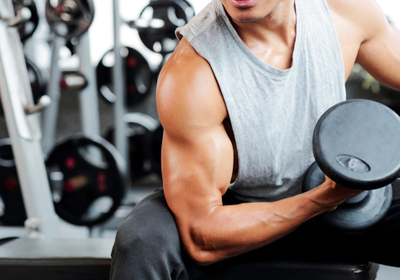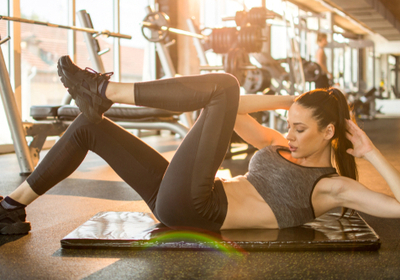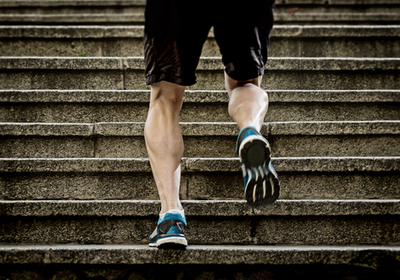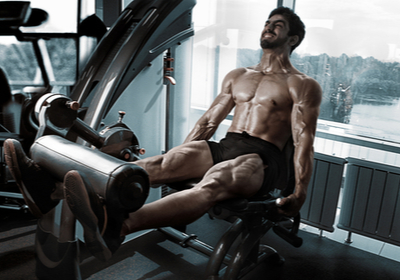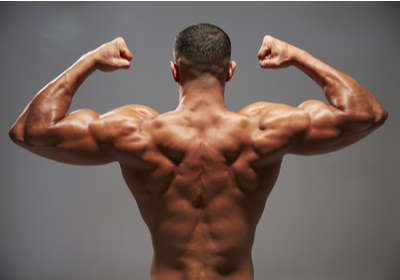Blog
Categories
Many people believe that biceps is extremely difficult to train. Moreover, they say that this muscle simply does not grow and those people who do manage to develop biceps are simply genetically gifted. Talking about genetics, it’s true, some people really can grow muscles faster. But the thought that the biceps is hard to train is a myth. So let's talk about biceps and figure out how to train them correctly together.
What Is Biceps?
From the point of view of biomechanics, when we bend our arms, the biceps muscle of the shoulder completely tenses. That means that there is no specific movement to tighten the inner or outer part of the biceps. And there are no special exercises to create gorgeous biceps like the legendary Arnold Schwarzenegger had.
As a matter of fact, the shape of your arm is a genetically determined factor, which is why you either have a relief biceps or don’t. So all you can do is just put up with it. In any case, well-developed arms look great regardless of their genetically determined shape. The most important thing here is that it is not difficult to develop them if you do it wisely, both from the point of view of physiology and the training process.
How to Grow Muscles?
Before moving on to the exercises, let's take a look at the main factors of muscle growth. This is necessary for a clear understanding of the appropriateness of the exercises, which we will consider below.
To put it simply, muscle development requires building materials (amino acids), energy (glucose), hormones (that your body synthesizes as a response to training stress), as well as muscle tension, which initiates growth. Moreover, sufficient muscle tension is perhaps the most important factor, without which there will be no progress. Accordingly, for the effective development of muscles, including the biceps, it is necessary to create conditions of tangible muscle tension without unnecessary stress on the ligaments and tendons. This is achieved by proper exercise techniques and an understanding of biomechanics.
In the case of the biceps muscle of the shoulder, the width of the barbell grip does not matter simply because any flexion of the arm makes your biceps tense. Thus, your grip should be comfortable to maximize muscle tension with minimal stress on your hands and elbows. This is much more effective than trying to train the outer and inner biceps heads separately by varying the width of the grip. Once you feel no or little muscle tension while doing exercises with a barbell, you can increase the weight but you must be extremely careful with that not to overload your joints and ligaments.
Exercises for Developing Gorgeous Biceps
Finally, let’s take a look at some biceps workouts, so here they come:
Barbell Curl
Cable Curl
Chin-Up
Reverse-Grip Bent-Over Row
EZ-Bar Preacher Curl
Cable Hammer Curl
Hammer Curl
Concentration Curl
Incline Dumbbell Curl
Wrapping Up
Well-developed biceps make your arms look simply stunning and, luckily, you can easily achieve this goal by doing certain exercises. Therefore, if you dream of gorgeous biceps, start training now.
Read more
The path to beautiful abs should not start with the question 'How to strengthen abdominal muscles?' The thing is that the visual image of a flat stomach depends on the percentage of body fat. This means that the way your abs will look not only depends on the number of crunches you do but on the quantity and quality of your food. So today we are going to talk about the tips for getting gorgeous abs.
Abs vs Food
Nutrition is extremely important for getting abs. In fact, your coach will probably give individual nutrition recommendations after testing, but there is one universal rule that everyone should follow - eat healthy food. In particular, you should avoid eating bakery, sugar-containing foods, and salty snacks. On the contrary, you have to eat more vegetables, fruits, herbs, nuts and seeds, as well as meat or other high-protein foods.
Getting Started
Before starting a workout, it is important to obtain data on your body condition. This means that the best place to start is fitness testing. Your trainer will ask you some questions in order to learn about your lifestyle, test your ability to move, and measure you. Then the coach will recommend the activities that will be safe and effective for you.
Popular Abs Workouts
It is believed that the best ab exercises are the training of the rectus abdominis muscles, which perform the function of flexing the body and keeping it upright. But this is just the tip of the iceberg. You also want to work on the deep muscles, which are part of your core and include the muscles of the abdomen, back, thighs, and buttocks. Their function is to help the body maintain posture and balance in an upright position. As a matter of fact, if your core is not strong enough, you will most likely experience discomfort while doing other exercises. Strengthening the core should be your top priority and you can do that with the help of TRX loops, plank and its variations, as well other bodyweight exercises.
Exercises for Strengthening Core and Abs
As we have mentioned above, to have gorgeous abs, you have to make sure you not only work on your abdominal muscles but on your entire core. So here are some exercises for improving all these muscles:
Diagonal twists
Plank
Pushups
Plank push-ups
Crunches
Leg lifts from lying position
Wrapping Up
As you can see, getting gorgeous abs is totally possible if you know how to work on them. Healthy nutrition and regular exercises will help you sculpt the body of your dreams, so do not hesitate and start going toward your dream now.
Read more
The calf muscles are often neglected in the early training stages when people concentrate on working out the chest, arms, and back. As a result, exercises for building calves are postponed or performed extremely rarely, which leads to a lack of progress. The muscles of the lower legs, as well as the deep muscles of the back, practically do not rest during the day, as they have to bear the weight of the body, help maintain balance, and stabilize the joints when walking. This means that it is focused on a low level of development and the way of working with it should be different.Here are some exercises for calves.
Calves 45Among all the exercises this one is aimed at developing the calf muscles, it is also one of the most difficult ones. It's all about changing the angle of the legs, which allows you to use not only the calves but also the soleus. To perform this exercise, you need Gakkenshmidt's Machine. Depending on the design, you will be facing it or not. Set a suitable operating weight. It is calculated as the arithmetic average between the working weights in the two previous exercises. Next, select the weights according to the loads. Then you need to lower the heels, trying to stretch the calf as much as possible. Perform a toe lift. Lock in the position of extreme tension for 1-2 seconds.
Calf raises with dumbbellsThis exercise is designed for athletes of any level and is considered the main one for working out the calf muscles. Stand on a wooden block. You can perform a movement in Smith, getting a step platform under your feet, and put the barbell on your shoulders. Fix the body in a straight position. If additional weight is required, dumbbells or weights should be taken. Next, you need to lower your heels below the level of the bar, trying to stretch the ankle as much as possible. Rise on your toes with a powerful impulse movement. Stay in this position for 1-2 seconds and tighten the calves. Slowly lower and get back to the starting position.
Seated calf raisesThis exercise is great for lazy training and will be a perfect option for beginners. Sit on the machine seat. Place the toes of the feet on the support step. Lower your heels to the floor as much as possible. Lower the lever with soft stops on your knees and lock.
Leg pressLie on a leg press machine. This uncommonly effective device for working out the legs can be used for training the calf muscles. Look for the platform where the legs would be straight. Fix the speed. You only need to do two actions. Remove the platform from the stops and squeeze it out with your toes. Return the socks to their original position.
It is important to know that the effect of posture on the development of the lower leg and calf muscles is much stronger than the effect of training. Flat feet, if not taken into account and not compensated, also interfere with bringing the shape of the lower leg. To improve your calves without exercising machines, you can simply choose the right shoes and adjust your gait.
Wrapping Up
Developed calves not only help you perform certain exercises better but also make your legs look simply gorgeous. Therefore, take another look at these exercises and make sure to at least give them a try while working out next time.
Read more
While working out most people pay lots of attention to their legs, arms, and abs and quite often they forget about the muscles of their spine, in particular, the lower back. Today, we are going to talk about the health of your lower back as well as how to strengthen these muscles.
Anatomy of Lower Back Muscles
The deep muscles of the back are some of the smallest but strongest muscles that support the spine. Most people mistakenly believe that small is insignificant, but when it comes to these muscles, this is completely wrong. The deep muscles of the back represent a set of muscles that attach to the spine. These muscles are composed of many thick, sinewy bundles that fill the grooves on either side of the spinous processes of the vertebrae and extend from the sacrum to the second cervical vertebra. These muscles spread over 2-4 vertebrae and stabilize the joints at all segmental levels, which allows each vertebra to work more efficiently and reduces the risk of degeneration of the articular structures.
The origin of the deep muscles of the back is the posterior surface of the sacrum, the posterior iliac spines, the mastoid processes of the lumbar vertebrae, and the transverse processes of the thoracic vertebrae. These muscles are attached to the spinous processes of the vertebrae 2-4 segments above the beginning of the muscle.
Exercises for the Lower Back Muscles
In order to keep your lower back strong and healthy, you need to do some simple exercises for this muscle group. So let us take a brief look at those.
Harvesting Apples
Starting in the mountain pose. Raise your hands up and begin to stretch your left hand even higher as if you are trying to reach an apple from a branch above your head. Bend your right knee, pull up your right thigh. Inhale and try to feel the tension in the left square muscle of the lower back. Exhale and relax. Repeat this on the other side. Do 10 repetitions on each side.
Side Stretching
Sit on the floor, resting on your knees, with your hands resting on the floor just below your shoulders. Bring your knees and inner thighs together. Move your hips to the left until you feel comfortable, the left hip is on the bottom, the right is on the top. In this position, look over your right shoulder. Inhale and stretch out along the left lower back and thigh. Exhale, return to the starting position and do the same on the right side. Alternate sides, each time going through the starting position. After doing a few repetitions on each side, you can do the child's pose and rest a little.
Belly Roll
Place a pillow or bolster against your left thigh, then swing your torso towards the pillow. Continuing to stretch in the spine, place your hands on the sides of the pillow and bend over until you touch the pillow with your ribs and chest. Turn your head to the side that is most comfortable for you. Bend your hips and knees until you find a position with a pleasant, light pull on your right side, allowing your right hip to stretch in the opposite direction from your lower ribs. Relax in this position for a few minutes. Then take a few deep breaths and change sides.
Final Word
Developed lower back muscles will help you maintain your back health, which is why you definitely want to work on these muscles. So why don’t you do some of the exercises we mentioned in this article right now?
Read more
The quadriceps is a large and strong muscle that plays the role of the main extensor of the knee joint. Since the knee joint carries the bulk of body weight, the quadriceps is the main muscle of the lower part of the thigh. In fact, if this muscle was weak, people simply would not be able to keep an upright posture. The quadriceps muscle consists of the following parts: straight, internal, external, and middle. Despite this, the load during a variety of exercises falls entirely on this muscle.
Workouts for Quads
Of course, it is very important to strengthen your quadriceps, so let us take a brief look at some of the best exercises for these muscles.
Barbell and dumbbell lungesLunges can be done in different ways - with a barbell, dumbbells, walking around the hall, or from a standing position. Consider options in which the athlete stands in one place, using either a barbell or dumbbells. It is similar to the position when squatting with a barbell on the back. Step forward with your right foot. The lunge should be such that the thigh of the working leg at the lowest point is parallel to the floor. At the same time, the knee of the left leg almost touches the floor and also forms a right angle. Return to the previous position. Swap legs - lunge with your left leg forward.
Leg pressThe leg press eliminates the work of the back and buttocks as much as possible. At the same time, the simulator makes it possible to work with a much higher weight than in squats. In order for the load to fall on the quadriceps, you need to press when setting your feet shoulder-width apart. The execution technique is the following: the back and head are tightly pressed against the back of the simulator, the legs are almost completely straightened and rest against the frame, the hands firmly hold the handles. Bend your knees to form a right angle between your hips and lower legs. Return the legs to the previous position.
One leg squatsCan't go to the gym? Squat on one leg. This is a great exercise for the quadriceps, with which you can load your legs without using additional weights. Start in a standing position, slightly extend one leg forward. Squat down, extending the leg forward and straightening it. Return to the previous position. Do at least 10 repetitions for each leg.
Kick SquatStand with your feet shoulder-width apart and your toes slightly turned to the sides. Place your hands on your belt or hold them near your chest. The emphasis should be on the middle of the foot. Sit down in a horizontal position of your hips, do not forget to keep your back straight. Stand up and shift your weight to one side. Raise your knee to a horizontal position and kick. The kick should go in one motion.
Fitball squatsPlace your feet slightly wider than your shoulders, turn your toes to the sides at 45 degrees. Take the fitball, keep tension and natural deflection in your lower back, your shoulders should be straight as well as your neck. Take a fitball and raise your arms to shoulder level. Along with inhaling, start to bend your knees to the sides, making sure they do not protrude over your toes. At the same time, your buttocks should go down first. The center of gravity lies on your heels. While squatting down, slightly get your back forward, with outstretched arms and raise the fitball above your head. Do 30-50 repetitions.
Final Thoughts
Everyone dreams of beautiful legs and, luckily, getting gorgeous quads is not that difficult at all if you know what you are doing. So why don’t you give these exercises a try?
Read more
The trapezius is an extremely important muscle group that helps us to have a nice posture. Obviously, training these muscles is essential for every athlete and sports enthusiast. In this article, we are going to talk about the anatomy of the trapezius as well as how to build these muscles. So without any further ado, let us begin.
Anatomy of Trapezius
Trapezius and neck muscles are a part of the upper back and they consist of two layers. These muscles resemble a trapezoid, which is a geometry shape they had their name from. This muscle group can be divided into several parts, which are:
top
medium
bottom
Trapezius muscle symmetrically spreads to the side from the upper part of the vertebral column, imparting upward to the cervical vertebrae and to the back. The muscle fibers of the middle part of the trapezius are attached to the outer edges of the collarbones and scapular bones, and the fibers of the lower part are attached to the shoulder blades.
There are a lot of different functions of this muscle. In particular, the upper part of the trapezium is responsible for the rise of the shoulder as well as for the ability to raise arms. The lower part of the trapezius muscle is responsible for lowering the shoulders and arms. Finally, the middle trapezoidal zone assists in shoulder blade movement.
Peculiarities of Training
Since the functions of the various parts of the trapezius muscle are different, you need to perform a variety of exercises to train each of them. The middle and lower trapezius work well when the muscles of the back are in tension, therefore, any kind of pull-ups in the incline and weight lifting will work. For the upper part of the trapezius, you want to do exercises with dumbbells. The most important thing here is to be consistent in your training and you will no doubt see the results.
Exercises for Building Trapezius Muscles
Finally, let us take a brief look at some of the exercises for building these muscles. So here they come:
Shrug
Shoulder blade squeeze
Upright row
Chin-up
Push-up
Rear delt cable raise
Overhead farmer's walk
Rope rear delt pull
Y raise
High pulley cable row
Final Word
Trapezius muscles are very important for right posture and your back health, which is why no matter if you're a professional athlete or an office worker, you have to work on these muscles. So why don’t you start right now?
Read more

